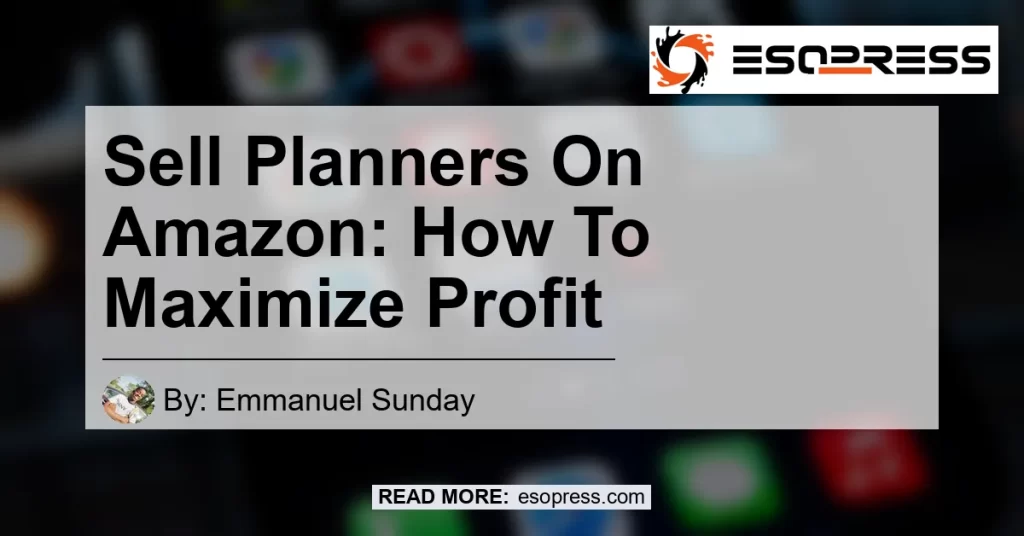

As an entrepreneur or creative individual, selling planners on Amazon can be a lucrative opportunity to showcase your unique designs and generate income. Amazon, being one of the largest online marketplaces, provides a vast customer base and a seamless selling experience. In this comprehensive guide, we will walk you through the step-by-step process of creating and selling planners on Amazon, allowing you to maximize your profit potential.
Contents
- 1 Table of Contents:
- 2 Finding Your Niche
- 2.1 1. Research popular planner themes and categories on Amazon.
- 2.2 2. Look for underserved markets or sub-niches.
- 2.3 3. Identify high-demand niches with fewer competitors.
- 2.4 4. Consider the specific needs and pain points of your target audience.
- 2.5 5. Create a unique selling proposition for your planner.
- 3 Creating Interior Pages
- 4 Designing Your Planner Cover
- 4.1 1. Know Your Audience: Research the design preferences and aesthetics commonly found in your target market. This will help you create a visually compelling cover that resonates with your potential customers.
- 4.2 2. Branding and Logo: Incorporate your brand logo or name on the cover to establish brand recognition and credibility. This will also help customers differentiate your planner from others in the marketplace.
- 4.3 3. High-Quality Imagery: Use high-resolution images or illustrations that are relevant to the theme of your planner. Ensure that the images are clear, visually appealing, and evoke a positive emotional response.
- 4.4 4. Eye-Catching Typography: Choose fonts that are easy to read and align with the overall design of your planner. Experiment with typography styles and consider using bold or stylized fonts to make key elements stand out.
- 4.5 5. Color Palette: Select a color palette that complements your theme and evokes the desired mood or emotion. Avoid using too many colors that may overwhelm the design or distract from the main message.
- 5 Formatting and Uploading Your Planner
- 5.1 1. File Format: Save your planner as a PDF file, ensuring that it is compatible with Amazon’s publishing guidelines.
- 5.2 2. Page Size and Margins: Set the page size to match Amazon’s recommended dimensions for planners. Ensure that the margins are appropriate, allowing for printing without any content being cut off.
- 5.3 3. Include Page Numbers: Add page numbers to your planner’s interior pages, making it easier for users to navigate and reference specific sections.
- 5.4 4. Pricing: Determine the pricing for your planner based on factors such as production costs, competition, and perceived value. Research similar planners on Amazon to get an idea of the price range within your niche.
- 5.5 5. Upload to KDP: Sign in to your Kindle Direct Publishing account and follow the instructions to upload your PDF file. Fill in all the necessary details, including the title, author name, keywords, and description.
- 5.6 6. Proofread and Preview: Before finalizing your upload, proofread your planner thoroughly to avoid any grammatical or formatting errors. Utilize the preview feature provided by Amazon to ensure that your planner appears as intended.
- 6 Optimizing Your Product Listing
- 6.1 1. Relevant Keywords: Include relevant keywords in your title, subtitle, and product description. Research popular search terms within your niche and incorporate them naturally to improve your product’s visibility in search results.
- 6.2 2. Compelling Description: Write a compelling and informative product description that highlights the unique features and benefits of your planner. Clearly communicate how it can solve the pain points of your target audience and make their lives easier.
- 6.3 3. Professional Images: Include high-quality images of your planner from various angles to give potential customers a better sense of its design and features. Use lifestyle images to showcase the planner in use, evoking a desire to purchase.
- 6.4 4. Reviews and Ratings: Encourage customers to leave reviews and ratings for your planner. Positive reviews not only boost your product’s reputation but also increase its visibility in Amazon’s search algorithm.
- 6.5 5. Categories and Subcategories: Select relevant categories and subcategories for your planner to ensure it appears in the right browsing sections on Amazon. This will improve its discoverability by customers interested in your niche.
- 7 Marketing Your Planner
- 7.1 1. Social Media Promotion: Leverage social media platforms like Instagram, Facebook, and Pinterest to create visually appealing content that showcases your planner. Engage with your audience through posts, stories, and live videos to build a loyal following.
- 7.2 2. Influencer Collaborations: Partner with influencers in your niche to promote your planner to their followers. This can significantly increase your product’s exposure and credibility.
- 7.3 3. Email Marketing: Build an email list by offering a free printable planner or exclusive discounts to customers who opt-in. Utilize email marketing campaigns to nurture relationships with potential customers and promote your planner regularly.
- 7.4 4. Amazon Advertising: Consider running advertising campaigns on Amazon to increase your product’s visibility. Sponsored Product Ads and Display Ads are effective tools for targeting relevant keywords and reaching potential customers.
- 7.5 5. Content Marketing: Create valuable and informative content related to your planner’s niche. This can include blog posts, video tutorials, or podcasts that provide tips and insights to your target audience. Incorporate links to your planner within the content to drive traffic and conversions.
- 8 Increasing Sales and Maximizing Profit
- 8.1 1. Monitor Sales and Metrics: Regularly analyze your sales data, conversion rates, and customer feedback to identify areas for improvement. Adjust your pricing, marketing strategies, and product features based on customer preferences and market trends.
- 8.2 2. Offer Bundles or Special Editions: Create limited-time bundles or special editions of your planner to generate excitement and incentivize purchases. This strategy can boost sales and create a sense of urgency among customers.
- 8.3 3. Upsell and Cross-sell: Implement upselling and cross-selling tactics by recommending related products or additional planner accessories to customers during the checkout process. This can increase the average order value and maximize profit per customer.
- 8.4 4. Utilize Fulfillment by Amazon (FBA): Consider using Amazon’s FBA program to handle storage, packaging, and shipping of your products. This ensures faster delivery and enhances the overall customer experience.
- 8.5 5. Customer Engagement and Loyalty: Foster customer loyalty by providing exceptional customer service, promptly responding to inquiries, and offering personalized recommendations. Implement a loyalty program to reward repeat customers and encourage referrals.
- 9 Conclusion
Table of Contents:
- Introduction
- Finding Your Niche
- Creating Interior Pages
- Designing Your Planner Cover
- Formatting and Uploading Your Planner
- Optimizing Your Product Listing
- Marketing Your Planner
- Increasing Sales and Maximizing Profit
- Conclusion
Selling planners on Amazon through the Kindle Direct Publishing (KDP) platform has become increasingly popular in recent years. KDP allows you to create and publish your own content, making it accessible to millions of potential buyers on Amazon. By leveraging the power of KDP and using design tools like Canva, you can easily create beautiful planners that cater to specific niches, resonating with potential customers looking for organized solutions to manage their lives.
Finding Your Niche
The first step in creating a successful planner is to identify your target audience or niche. Take some time to research popular planner themes and categories on Amazon. Look for underserved markets or sub-niches that have high demand but fewer competitors. For example, you could focus on daily productivity planners, fitness and meal planners, or even specialized planners for students or entrepreneurs. By targeting a specific audience, you can tailor your planner to their unique needs and stand out from the competition.
To find a profitable niche, use the following steps:
1. Research popular planner themes and categories on Amazon.
2. Look for underserved markets or sub-niches.
3. Identify high-demand niches with fewer competitors.
4. Consider the specific needs and pain points of your target audience.
5. Create a unique selling proposition for your planner.
Creating Interior Pages
Once you have identified your niche, it’s time to create the interior pages of your planner. This step involves designing layouts, templates, and content that will resonate with your target audience. There are two options for creating interior pages: designing them from scratch or purchasing pre-made templates.
Option 1: Designing From Scratch
If you have design skills or prefer a more customized approach, you can create your own interior pages using design software like Canva. Canva offers a user-friendly interface with a wide range of templates, graphics, and fonts to choose from. Start by mapping out the structure and flow of your planner, incorporating sections for goal-setting, habit tracking, weekly or monthly calendars, to-do lists, and other relevant features. Make sure to align your design with your chosen niche and target audience.
Option 2: Purchasing Pre-Made Templates
If you’re looking to save time and effort, you can also purchase ready-made planner templates from online marketplaces like Etsy or Creative Market. These templates are typically customizable, allowing you to edit the content and design elements to match your branding and niche. Be sure to choose templates that are compatible with Canva or another design software of your choice, ensuring a seamless editing process.
Designing Your Planner Cover
The cover of your planner plays a crucial role in attracting potential buyers. It serves as the first impression and should accurately represent the content and style of your planner. When designing your planner cover, keep the following tips in mind:
1. Know Your Audience: Research the design preferences and aesthetics commonly found in your target market. This will help you create a visually compelling cover that resonates with your potential customers.
2. Branding and Logo: Incorporate your brand logo or name on the cover to establish brand recognition and credibility. This will also help customers differentiate your planner from others in the marketplace.
3. High-Quality Imagery: Use high-resolution images or illustrations that are relevant to the theme of your planner. Ensure that the images are clear, visually appealing, and evoke a positive emotional response.
4. Eye-Catching Typography: Choose fonts that are easy to read and align with the overall design of your planner. Experiment with typography styles and consider using bold or stylized fonts to make key elements stand out.
5. Color Palette: Select a color palette that complements your theme and evokes the desired mood or emotion. Avoid using too many colors that may overwhelm the design or distract from the main message.
Formatting and Uploading Your Planner
Once you have designed your interior pages and cover, it’s time to format and upload your planner to the Kindle Direct Publishing platform. Follow these steps to ensure a seamless publishing process:
1. File Format: Save your planner as a PDF file, ensuring that it is compatible with Amazon’s publishing guidelines.
2. Page Size and Margins: Set the page size to match Amazon’s recommended dimensions for planners. Ensure that the margins are appropriate, allowing for printing without any content being cut off.
4. Pricing: Determine the pricing for your planner based on factors such as production costs, competition, and perceived value. Research similar planners on Amazon to get an idea of the price range within your niche.
6. Proofread and Preview: Before finalizing your upload, proofread your planner thoroughly to avoid any grammatical or formatting errors. Utilize the preview feature provided by Amazon to ensure that your planner appears as intended.
Optimizing Your Product Listing
To increase your chances of success on Amazon, it’s vital to optimize your product listing for discoverability and conversion. Follow these optimization tips:
1. Relevant Keywords: Include relevant keywords in your title, subtitle, and product description. Research popular search terms within your niche and incorporate them naturally to improve your product’s visibility in search results.
2. Compelling Description: Write a compelling and informative product description that highlights the unique features and benefits of your planner. Clearly communicate how it can solve the pain points of your target audience and make their lives easier.
3. Professional Images: Include high-quality images of your planner from various angles to give potential customers a better sense of its design and features. Use lifestyle images to showcase the planner in use, evoking a desire to purchase.
4. Reviews and Ratings: Encourage customers to leave reviews and ratings for your planner. Positive reviews not only boost your product’s reputation but also increase its visibility in Amazon’s search algorithm.
5. Categories and Subcategories: Select relevant categories and subcategories for your planner to ensure it appears in the right browsing sections on Amazon. This will improve its discoverability by customers interested in your niche.
Marketing Your Planner
While Amazon provides a vast customer base, it’s crucial to take proactive measures to market your planner effectively. Here are some strategies to consider:
2. Influencer Collaborations: Partner with influencers in your niche to promote your planner to their followers. This can significantly increase your product’s exposure and credibility.
3. Email Marketing: Build an email list by offering a free printable planner or exclusive discounts to customers who opt-in. Utilize email marketing campaigns to nurture relationships with potential customers and promote your planner regularly.
4. Amazon Advertising: Consider running advertising campaigns on Amazon to increase your product’s visibility. Sponsored Product Ads and Display Ads are effective tools for targeting relevant keywords and reaching potential customers.
Increasing Sales and Maximizing Profit
As you build momentum and begin generating sales, it’s essential to continually optimize your strategy to increase sales and maximize profit. Here are some tips to help you achieve this:
1. Monitor Sales and Metrics: Regularly analyze your sales data, conversion rates, and customer feedback to identify areas for improvement. Adjust your pricing, marketing strategies, and product features based on customer preferences and market trends.
2. Offer Bundles or Special Editions: Create limited-time bundles or special editions of your planner to generate excitement and incentivize purchases. This strategy can boost sales and create a sense of urgency among customers.
4. Utilize Fulfillment by Amazon (FBA): Consider using Amazon’s FBA program to handle storage, packaging, and shipping of your products. This ensures faster delivery and enhances the overall customer experience.
5. Customer Engagement and Loyalty: Foster customer loyalty by providing exceptional customer service, promptly responding to inquiries, and offering personalized recommendations. Implement a loyalty program to reward repeat customers and encourage referrals.
Conclusion
Selling planners on Amazon can be a profitable venture if approached strategically. By following the steps outlined in this guide, from finding your niche to optimizing your product listing and implementing effective marketing strategies, you can increase your chances of success. Remember to continuously assess and adapt your approach based on market trends, customer feedback, and competitor analysis.
In conclusion, after reviewing various products available on Amazon for selling planners, the best product that suits the needs of both entrepreneurs and individuals looking to stay organized is the Leuchtturm1917 Medium A5 Hardcover Notebook. It is a popular brand known for its high-quality notebooks and is favored by many planner enthusiasts. With its durable cover, numbered pages, and various organizational features, the Leuchtturm1917 Medium A5 Hardcover Notebook offers the perfect balance of functionality and style.
Click here to check out the Leuchtturm1917 Medium A5 Hardcover Notebook on Amazon.


Start your journey of selling planners on Amazon today and unlock your potential for profit and success!






